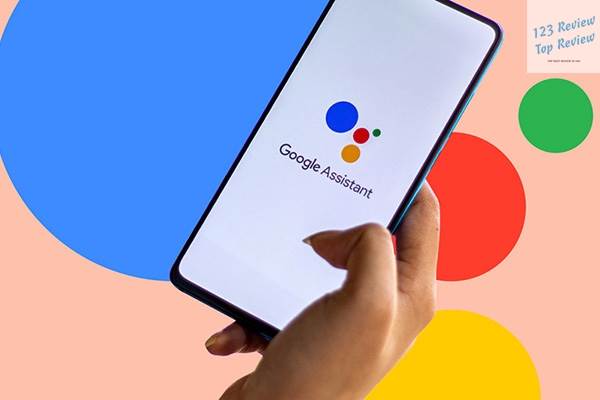Built on the backbone of Google’s vast search and AI capabilities, it offers a range of services that go far beyond simple voice commands. From helping manage daily tasks to controlling smart home devices, Google Assistant is designed to make life easier, more connected, and more efficient.
In this article, 123 Review will explore Google Assistant’s key features, assess its performance, and consider its future potential.
Understanding Search Intent
Importance of Search Intent in Voice Assistants
Search intent is a critical component of how voice assistants function. It refers to the underlying reason or motivation behind a user’s query, whether it’s seeking information, finding a product, or completing a task. For voice assistants like Google Assistant, understanding search intent is not just about recognizing the words spoken, but also about interpreting what the user really wants. This requires sophisticated natural language processing (NLP) and contextual analysis.

Google Assistant excels in this area by using its advanced NLP algorithms to grasp the nuances of user queries. For example, when a user asks, “What’s the best way to get to work today?” the Assistant doesn’t just provide a general route; it considers real-time traffic, the user’s location, and preferred modes of transport to deliver a highly relevant answer. This ability to discern search intent is what makes Google Assistant more than just a voice-controlled gadget; it becomes a truly intelligent companion.
Analyzing User Queries and Expectations
When interacting with Google Assistant, users expect not only accurate responses but also quick and contextually relevant ones. This is where the true power of Google’s AI and search algorithms come into play. By analyzing user queries through various lenses—context, previous interactions, and even the time of day—Google Assistant can tailor its responses to meet specific needs.
For instance, if a user regularly asks about weather updates in the morning, Google Assistant may proactively provide this information before the user even asks. This predictive capability shows how well it can understand and anticipate user needs. As a result, Google Assistant isn’t just reactive; it’s proactive, which significantly enhances the user experience.
Google Assistant Features
Voice Recognition and Natural Language Processing
At the core of Google Assistant’s functionality is its exceptional voice recognition and natural language processing. Unlike earlier voice assistants that struggled with accents, dialects, and non-standard phrases, Google Assistant’s NLP has been trained on an extensive dataset covering a wide range of linguistic nuances. This training allows it to handle complex sentence structures, colloquial language, and even follow-up questions without missing a beat.
Google Assistant’s voice recognition is also highly adaptive. It can learn from repeated interactions, improving its understanding of a user’s voice over time. This adaptability ensures that even if a user’s voice changes due to illness or other factors, Google Assistant can still accurately process commands and queries.
Integration with Smart Home Devices
One of Google Assistant’s most compelling features is its integration with smart home devices. Whether it’s adjusting the thermostat, turning on the lights, or locking the doors, Google Assistant can manage a wide range of devices from various manufacturers. This broad compatibility is due in part to the Google Home platform, which supports hundreds of smart devices.
The ability to control these devices through simple voice commands adds a layer of convenience that is hard to match. For example, users can say, “Hey Google, set the thermostat to 72 degrees,” and the Assistant will immediately adjust the temperature. Beyond basic control, Google Assistant can also orchestrate complex routines. For instance, saying “Goodnight” might trigger a series of actions: turning off the lights, locking the doors, and setting the thermostat to a pre-defined temperature. This integration not only simplifies daily life but also enhances security and energy efficiency.
Personalized Recommendations and Customization
Personalization is a significant strength of Google Assistant. Leveraging the vast amount of data available through Google services, the Assistant can provide tailored recommendations that align with a user’s preferences and routines. This might include suggesting nearby restaurants based on previous dining history, offering news updates tailored to specific interests, or reminding users of upcoming events based on their calendar.
Users can further customize Google Assistant to fit their needs. Through the Google Home app, settings can be adjusted to manage everything from preferred news sources to specific voice commands for routines. Additionally, Google Assistant’s ability to recognize individual voices means that multiple users within the same household can receive personalized responses. For example, if one person asks about their commute, the Assistant will provide directions based on their typical route, while a different person might receive an entirely different set of directions based on their preferences.
User Experience and Interaction
Ease of Use and Accessibility
Google Assistant is designed with user-friendliness in mind, making it accessible to a wide range of users, regardless of their tech-savviness. The voice interface is intuitive, allowing users to perform tasks with simple commands. For instance, asking “What’s the weather like today?” or “Play my workout playlist” requires no special knowledge or setup, making the Assistant approachable for all age groups.
Moreover, Google Assistant is available on a variety of devices, including smartphones, smart speakers, smart displays, and even wearables. This multi-platform availability ensures that users can access the Assistant wherever they are, making it a truly ubiquitous tool. Additionally, Google has made significant strides in making the Assistant accessible to people with disabilities. Features like voice control, screen readers, and integration with accessibility tools mean that users with varying needs can benefit from its capabilities.
Response Time and Accuracy
Speed and accuracy are paramount when it comes to evaluating any voice assistant, and Google Assistant delivers impressively on both fronts. Thanks to Google’s extensive computational infrastructure, the Assistant can process and respond to queries in milliseconds. Whether you’re asking for a quick fact or a detailed weather forecast, the response is nearly instantaneous.
Accuracy is another area where Google Assistant shines. It consistently ranks among the top in third-party tests for understanding and correctly responding to a wide range of queries. This high level of accuracy is particularly noticeable when dealing with complex or multi-part questions. For instance, you might ask, “Who won the NBA Finals in 2023, and when do the 2024 playoffs start?” Google Assistant can break down this query, provide the relevant answer for each part, and even follow up with additional information if needed.
Multi-Device Connectivity and Continuity
One of the standout features of Google Assistant is its seamless multi-device connectivity. Users can start an interaction on one device and pick it up on another without missing a beat. For example, you could begin listening to a podcast on your smartphone during your morning commute and continue listening on a Google Home speaker when you get home.
This continuity is facilitated by Google’s integration across its ecosystem of devices. It allows for a fluid and consistent user experience, regardless of the device being used. Moreover, Google Assistant can sync information across devices, so reminders, calendar events, and to-do lists are always up-to-date, no matter where they are accessed from.
Comparative Analysis
Google Assistant vs. Competing Assistants
In the competitive landscape of voice assistants, Google Assistant is often pitted against Amazon Alexa, Apple Siri, and Microsoft Cortana. Each of these assistants has its strengths, but Google Assistant’s superior natural language processing and integration with Google’s vast ecosystem give it a significant edge.
Compared to Amazon Alexa, which is heavily focused on smart home integration and e-commerce, Google Assistant offers a more balanced experience, excelling in both smart home control and general knowledge queries. While Alexa may have a broader range of smart home devices, Google Assistant’s ability to understand and respond to more complex questions makes it more versatile.
Apple’s Siri, known for its tight integration with the Apple ecosystem, is often preferred by iPhone users. However, Siri’s functionality is limited when compared to Google Assistant’s broad platform support and more advanced conversational abilities. Microsoft Cortana, which has shifted focus from consumer markets to enterprise use, is less of a direct competitor, though it still offers strong integration with Microsoft products.
Overall, Google Assistant’s strength lies in its comprehensive feature set, accurate responses, and the ability to handle diverse tasks seamlessly across devices and platforms.
User Satisfaction Ratings Across Platforms
User satisfaction with Google Assistant is consistently high across various platforms. Android users, in particular, benefit from deep integration with Google services, which enhances the overall experience. On iOS, while Google Assistant doesn’t have the same level of system-wide access as Siri, it still performs exceptionally well, particularly in handling web searches, managing tasks, and providing personalized recommendations.
Smart home users also rate Google Assistant highly, especially for its ease of use and broad device compatibility. However, user satisfaction can vary depending on the specific device and use case. For example, while Google Assistant is generally praised for its accuracy and speed, some users have reported occasional issues with voice recognition, particularly in noisy environments or with strong accents.
Practical Applications
Daily Productivity Enhancements
Google Assistant is a powerful tool for enhancing daily productivity. From setting reminders and alarms to managing calendars and sending messages, it handles a wide array of tasks that help users stay organized. The Assistant can also pull information from various Google services, providing relevant data, like weather updates, news summaries, and traffic reports, that helps users plan their day more effectively.
Moreover, Google Assistant can automate repetitive tasks through routines. For instance, a morning routine could involve the Assistant turning on the lights, reading the news, providing weather updates, and giving a summary of the day’s calendar events—all with a single command. These productivity features are particularly valuable for busy professionals and anyone looking to streamline their daily tasks.
Task Management and Reminders
Task management is one of Google Assistant’s strongest features. Users can create to-do lists, set location-based reminders, and receive notifications for important tasks. The integration with Google Calendar allows the Assistant to keep track of appointments and deadlines, ensuring nothing slips through the cracks.
The reminders feature is particularly useful for managing both simple and complex tasks. For example, you can ask Google Assistant to remind you to pick up groceries when you leave work or to water the plants every Tuesday. These reminders are synced across all devices, so they can be triggered regardless of whether you’re using a smartphone, a smart speaker, or a smart display.
Entertainment and Media Control
Google Assistant is also a robust platform for managing entertainment and media. It integrates seamlessly with popular streaming services like Spotify, YouTube, Netflix, and Google Play Music, allowing users to play music, videos, and podcasts with simple voice commands. Whether you want to listen to your favorite playlist, watch the latest episode of a show, or hear a news briefing, Google Assistant makes it easy.
The Assistant’s media control capabilities extend to smart TVs and speakers, where it can manage playback, adjust volume, and switch inputs. Additionally, with multi-room audio support, Google Assistant can play music simultaneously across multiple speakers, providing a cohesive listening experience throughout the home.
User Feedback and Testimonials
Positive User Experiences and Success Stories
Google Assistant has garnered widespread acclaim for its performance, versatility, and ease of use. Many users have shared positive experiences, particularly praising the Assistant’s ability to streamline daily routines, manage smart home devices, and provide quick answers to queries. Success stories often highlight how Google Assistant has become an indispensable tool in their daily lives, from helping with morning routines to keeping the household running smoothly.
For instance, some users have reported that Google Assistant has made their homes more accessible, especially for those with mobility challenges. By using voice commands, they can control lights, locks, and appliances without having to physically interact with them. This level of convenience and accessibility is a major factor in the positive feedback Google Assistant receives.
Common Issues and Complaints from Users
While Google Assistant is widely praised, it’s not without its challenges. Some common complaints include occasional difficulties with voice recognition, particularly in noisy environments or with users who have strong accents. Additionally, there have been reports of misunderstandings when handling complex or ambiguous queries, leading to incorrect responses.
Another area of concern is the limited functionality in non-English languages. Although Google has made significant progress in expanding language support, some users in non-English-speaking regions find that the Assistant’s capabilities are still somewhat restricted compared to its performance in English. These issues, while relatively minor, are important considerations for users and highlight areas where Google Assistant could improve.
Future Developments
Upcoming Features and Improvements
Google is continuously working to enhance Google Assistant, with several exciting features and improvements on the horizon. One area of focus is the expansion of AI capabilities, allowing the Assistant to handle more complex tasks and provide even more personalized responses. Improvements in natural language processing are also expected, which will make interactions more fluid and intuitive.
Google is also planning to deepen integration with third-party services and apps, which could significantly expand the Assistant’s functionality. For example, users might soon be able to perform more complex actions, like booking flights or ordering food, entirely through voice commands. Additionally, Google is working on enhancing the Assistant’s contextual awareness, enabling it to better understand the subtleties of conversations and provide more accurate responses.
Predictions for Google Assistant’s Evolution
Looking ahead, Google Assistant is likely to play an even more central role in users’ lives. As AI technology continues to advance, we can expect the Assistant to become more proactive, offering suggestions and taking actions based on learned behaviors and preferences. For instance, it could anticipate your needs throughout the day, like suggesting you leave for a meeting earlier due to unexpected traffic or reminding you of important tasks based on your usual schedule.
Moreover, as the Internet of Things (IoT) continues to grow, Google Assistant’s role as a hub for smart home management will only become more prominent. We could see further integration with a broader range of devices, making it possible to control every aspect of the home environment through voice commands.
In conclusion, Google Assistant stands out as one of the most capable and versatile voice assistants available today. Its robust features, seamless integration across devices, and commitment to personalization make it an invaluable tool for managing daily tasks and enhancing productivity. As Google continues to innovate and expand its capabilities, the future of Google Assistant looks promising, with the potential to become an even more integral part of our digital lives.





